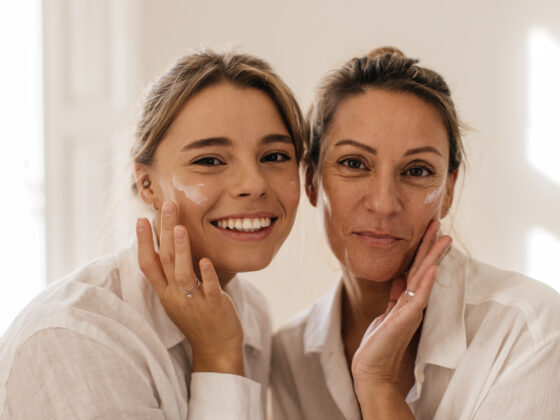Beautiful skin isn’t achieved with a one-size-fits-all approach. It’s the result of understanding your unique skin type and choosing skincare products tailored to your specific needs. This comprehensive guide will help you cater to your complexion by identifying different skin types and recommending appropriate skincare routines.
Navigate Your Way
Identifying Your Skin Type

The first step in choosing the right skincare for your skin type is to identify your skin type. This will guide your selection of skincare products and determine the kind of care your skin needs. The five main skin types are:
Normal Skin
Normal skin is well-balanced — not too dry, not too oily. This skin type has a good balance of moisture, small pores, and an even tone.
Oily Skin
Oily skin produces excess sebum, which leads to a shiny complexion, enlarged pores, and a higher likelihood of blackheads, pimples, or other types of acne.
Dry Skin
Dry skin lacks natural oils and may appear dull, rough, or flaky. It’s more susceptible to aging signs like wrinkles and fine lines due to lack of moisture.
Combination Skin
Combination skin is a mix of both dry and oily skin. Typically, the T-zone (forehead, nose, and chin) is oily, while the cheeks are dry.
Sensitive Skin
Sensitive skin may react with redness, irritation, or discomfort to certain products or environmental factors.
8 Steps Guide: The Right Skincare Ingredients for Your Skin Type

Now you will learn how to choose skincare products based on ingredients. What ingredients suit your skin type, how to read labels and use online tools and tests, and how to avoid mistakes and myths. You will also get tips from a dermatologist.
By the end of this section, you will be able to pick the right skincare products for your skin type.
Don’t Fall for the Hype
Don’t let fancy packaging or popular reviews sway your decision too much. You should focus more on your own skin type and needs than on what others are using. If you’re going to try a product based on someone else’s recommendation, make sure they have a similar skin type and condition as you. That way, you can have a more realistic expectation of how the product will work for you.
Some well-known skincare products and brands have faced lawsuits from customers who experienced severe side effects. This doesn’t mean that they’re bad for everyone, but it does remind us that not all products are suitable for all skin types. The best way to find out if a product is right for you is to check the ingredients list and see if they match your skin type and goals.
Look for These Ingredients
Glycerin: This ingredient is essential for moisturizing products.
Ceramides and hyaluronic acid: These ingredients are natural moisturizers found in the skin.67 They are preferred in serums and creams and lotions, respectively.
L-Ascorbic acid (Vitamin C): Vitamin C, especially in this form, is an antioxidant that can reverse sun damage and stimulate collagen production.8
Tocopherol (Vitamin E): Vitamin E has similar benefits as vitamin C and works best when combined with it.8If you want to splurge on a luxury hand cream, Augustinus Bader’s The Hand Treatment combines Vitamin E with glycerin and shea butter.
Retinol: Retinol is a key ingredient for your nighttime routine. It can speed up skin cell turnover and stimulate collagen.9
Niacinamide (Vitamin B3): This ingredient can help control oil production, hydrate the skin, and even out skin tone.1011
Avoid These Ingredients
Fragrance/parfum: Added fragrances can cause skin allergies and irritation, especially if you have sensitive skin.12
Sulfates: Sulfates are cleansing agents often found in body washes and shampoos. They can strip the hair and skin of their natural oil and cause irritation.
Parabens: Parabens are chemical preservatives that prevent bacterial growth in products. They can act like estrogen in the body and disrupt hormonal balance. This can be harmful for young children and people at risk of breast cancer.
Formaldehyde and formaldehyde releasers: Formaldehyde is a known carcinogen that is rarely used in products anymore. However, some products may contain chemicals (quaternium-15, DMDM hydantoin, diazolidinyl urea, imidazolidinyl urea) that release formaldehyde over time as preservatives.13 It’s not clear whether these ingredients are safe or not, but they can be potential allergens.
Don’t Assume Natural Is Better
Natural or organic products may sound appealing, but they’re not always better for your skin. For example, poison ivy is a natural oil, but you wouldn’t want to put it on your skin. Many people also have reactions to natural essential oils, so you need to be careful with what you use on your skin.
The terms natural and organic are not regulated or standardized in the skincare industry, so they may not mean much or be accurate. Sometimes, a product may claim to be natural or organic based on only one or two ingredients in the list.
Pay Attention to the Order of Ingredients
When you know what ingredients you want or don’t want in your products, you need to pay attention to where they are listed on the label. As a general rule, look at the first five ingredients, as they usually make up about 80 percent of the product.
Ingredients are listed from highest to lowest concentration, so if there’s an ingredient that you want to avoid or seek out among the first five listed, that will help you decide whether to buy or skip the product.
Don’t Be Afraid of the Long Ingredients List
When it comes to food, we often prefer shorter and simpler ingredients lists. But when it comes to skincare, a longer list may not be a bad thing. When you’re looking for anti-aging benefits or medical-grade skincare products, the list will naturally get longer because of the different active ingredients involved.
You shouldn’t be intimidated by a long list of ingredients, but rather use your resources to help you understand what they are and what they do for your skin.
Use Your Resources
You don’t have to memorize all the ingredients names and functions to pick the right skincare products. You can use online resources to help you research and compare products and ingredients. Two online databases that can help you are: Environmental Working Group’s (EWG) Skin Deep database and CosDNA.
The EWG Skin Deep database is part of a non-profit organization that focuses on research and education on environmental and human health issues. The database rates and scores skincare products based on various factors, such as manufacturing practices and potential health hazards.
CosDNA is a more simple database that gives more details on the ingredients in a product, such as their roles and safety scores.
Always Do a Patch Test
A patch test is a smart way to test a product or ingredient before using it on your face. It can help you avoid allergic reactions, irritation, or breakouts. If a product makes your skin worse or irritates your skin in any way, stop using it and find something else.
To do a patch test, apply a small amount of the product on a discreet area of your skin, such as behind your ear or on your inner arm. Wait for 24 hours and see if there’s any reaction. If not, you can proceed with using the product on your face. If yes, you should avoid the product and consult with a dermatologist if needed.
The Ultimate Skincare Routine for Each Skin Type

Catering to your skin’s unique needs is key to a successful skincare routine. Here, we’ve suggested products specifically tailored for normal, oily, dry, combination, and sensitive skin types. However, before starting any new skincare regimen, it’s always wise to consult with a dermatologist or skincare professional. Choose wisely and give your skin the care it deserves.
Normal Skin
Normal skin types have the most flexibility when it comes to skincare. Regular cleansing, toning, moisturizing, and SPF should keep the skin in balance. Use products that maintain your skin’s natural balance and hydration.
Morning Routine:
Cleanser: CeraVe Hydrating Facial Cleanser
Toner: Thayers Alcohol-Free Rose Petal Witch Hazel Facial Toner
Moisturizer: Neutrogena Hydro Boost Water Gel
SPF: EltaMD UV Clear Facial Sunscreen
Evening Routine:
Cleanser: CeraVe Hydrating Facial Cleanser
Exfoliant (2-3 times per week): Paula’s Choice Skin Perfecting 2% BHA Liquid Exfoliant
Moisturizer: CeraVe PM Facial Moisturizing Lotion
Oily Skin
For oily skin, choose oil-free and non-comedogenic products that won’t clog pores. Use a gentle cleanser to remove excess oil without stripping the skin. Incorporate toners, serums, and moisturizers that contain ingredients like salicylic acid and benzoyl peroxide, which can help regulate oil production and prevent acne.
Morning Routine:
Cleanser: La Roche-Posay Effaclar Purifying Foaming Gel Cleanser
Toner: The Ordinary Glycolic Acid 7% Toning Solution
Serum: The Ordinary Niacinamide 10% + Zinc 1%
Moisturizer: Cetaphil PRO Oil Absorbing Moisturizer
SPF: Paula’s Choice CLEAR Ultra-Light Daily Hydrating Fluid SPF 30+
Evening Routine:
Cleanser: La Roche-Posay Effaclar Purifying Foaming Gel Cleanser
Exfoliant (2-3 times per week): The INKEY List Salicylic Acid Acne + Pore Cleanser
Moisturizer: Neutrogena Hydro Boost Gel-Cream
Dry Skin
Dry skin needs products that provide deep hydration. Look for a gentle, creamy cleanser that doesn’t strip away natural oils. Your skincare routine should include hydrating serums, moisture-rich creams, and oils to lock in moisture. Ingredients like hyaluronic acid and glycerin can be particularly beneficial.
Morning Routine:
Cleanser: Vanicream Gentle Facial Cleanser
Serum: The Ordinary Hyaluronic Acid 2% + B5
Moisturizer: CeraVe Moisturizing Cream
SPF: La Roche-Posay Anthelios Melt-In Milk Sunscreen SPF 60
Evening Routine:
Cleanser: Vanicream Gentle Facial Cleanser
Exfoliant (2-3 times per week): The Ordinary Lactic Acid 10% + HA
Moisturizer: CeraVe Moisturizing Cream
Night Cream: Neutrogena Hydro Boost Gel-Cream Extra-Dry Skin
Combination Skin
Combination skin requires a balanced approach to skincare. Consider using different products for different areas of your face to address both oiliness and dryness. You might use oil-absorbing products on your T-zone and hydrating ones on your cheeks.
Morning Routine:
Cleanser: Cetaphil Gentle Skin Cleanser
Toner: Bioderma Hydrabio Tonique Moisturising Toning Lotion
Serum: The Ordinary Hyaluronic Acid 2% + B5 on dry areas and The Ordinary Niacinamide 10% + Zinc 1% on oily areas
Moisturizer: La Roche-Posay Toleriane Double Repair Face Moisturizer
SPF: La Roche-Posay Anthelios Ultra-Light Mineral Sunscreen SPF 50
Evening Routine:
Cleanser: Cetaphil Gentle Skin Cleanser
Exfoliant (2-3 times per week): Paula’s Choice SKIN PERFECTING 8% AHA Gel
Moisturizer: La Roche-Posay Toleriane Double Repair Face Moisturizer
Sensitive Skin
Sensitive skin requires gentle, hypoallergenic, and fragrance-free products to avoid causing irritation or redness. Look for calming ingredients like aloe vera, chamomile, and oats in your skincare products.
Morning Routine:
Cleanser: Aveeno Ultra-Calming Hydrating Gel Facial Cleanser
Toner: Paula’s Choice CALM Redness-Relief Toner
Serum: The Ordinary Hyaluronic Acid 2% + B5
Moisturizer: CeraVe Moisturizing Cream
SPF: EltaMD UV Clear Facial Sunscreen Broad-Spectrum SPF 46
Evening Routine:
Cleanser: Aveeno Ultra-Calming Hydrating Gel Facial Cleanser
Moisturizer: CeraVe Moisturizing Cream
The Benefits of Personalized Skincare

By catering to your complexion and choosing the right skincare for your skin type, you can enjoy many benefits, such as:
- Improved skin health and appearance
- Reduced risk of skin problems and complications
- Enhanced confidence and self-esteem
- Better value for money and less waste of products
Personalized skincare is not a luxury — it’s a necessity. Your skin is the largest organ of your body and deserves the best care possible. By following the tips and recommendations in this guide, you can create a skincare routine that works for you and your skin type. Remember, beautiful skin starts with you.
Tips and Tricks for Different Skin Types

Besides following a skincare routine that suits your skin type, there are some other tips and tricks that can help you achieve a flawless complexion. Here are some of them:
Normal Skin
Drink plenty of water to keep your skin hydrated from within.
Avoid using harsh or drying products that can disrupt your skin’s natural balance.
Exfoliate regularly to remove dead skin cells and reveal a smoother, brighter complexion.
Use a gentle face mask once or twice a week to nourish and pamper your skin.
Oily Skin
Blot excess oil with blotting papers or tissues throughout the day to prevent shine.
Avoid touching your face or picking at pimples, as this can spread bacteria and cause inflammation.
Use clay or charcoal masks once or twice a week to draw out impurities and unclog pores.
Use mattifying primers and foundations to control oil and create a smooth base for makeup.
Dry Skin
Avoid hot water, harsh soaps, and alcohol-based products that can strip away natural oils and moisture.
Apply moisturizer while your skin is still damp to seal in hydration.
Use a humidifier in your bedroom or office to add moisture to the air and prevent dryness.
Use creamy or hydrating masks once or twice a week to replenish moisture and soothe dryness.
Combination Skin
Use different moisturizers for different areas of
your face, such as a lightweight gel for your oily T-zone and a richer cream for your dry cheeks.
Use gentle cleansers that don’t over-dry or over-moisturize your skin.
Use multi-masking techniques to target different skin concerns at the same time, such as applying a clay mask on your oily areas and a hydrating mask on your dry areas.
Use oil-free or water-based makeup products to avoid clogging pores or causing dryness.
Sensitive Skin
Patch test new products on a small area of your skin before using them on your face to check for any adverse reactions.
Avoid products that contain artificial fragrances, colors, or preservatives, as these can trigger irritation or allergies.
Use soothing ingredients like oatmeal, aloe vera, or green tea to calm and comfort your skin.
Use sunscreen every day to protect your skin from sun damage and inflammation.
Use gentle or hypoallergenic makeup products that don’t irritate your skin or cause breakouts.
Wrapping Up

Your skin is one of a kind, and so is your skincare routine. By knowing your skin type and how it reacts to different ingredients and products, you can pamper your complexion with a skincare routine that boosts your natural beauty and supports skin health.
Keep in mind that your skin type can change due to factors like age, climate, and hormonal changes. Check your skin’s condition regularly and tweak your skincare routine as needed. Most importantly, be patient. It can take time to see the results of a new skincare routine, so stick with it and give your skin the time it needs to adapt.
Catering to your complexion isn’t just about looking good — it’s about giving your skin the love it needs to stay healthy and radiant for years to come.











